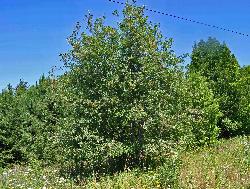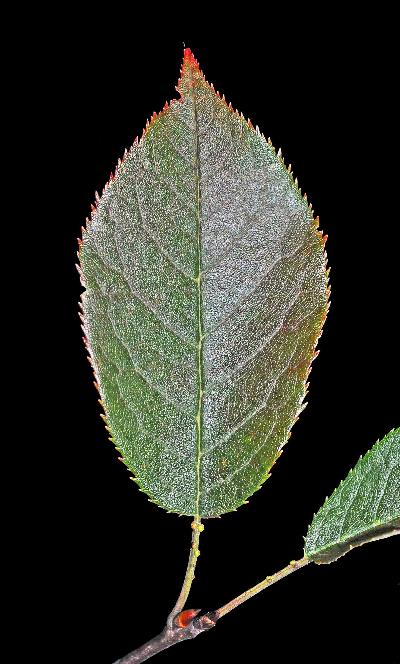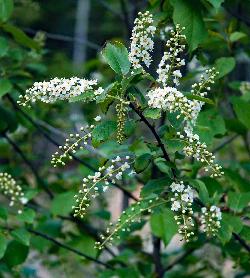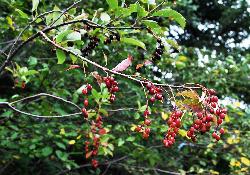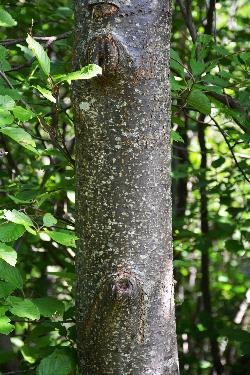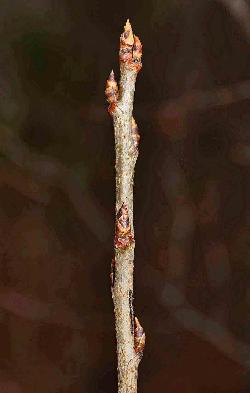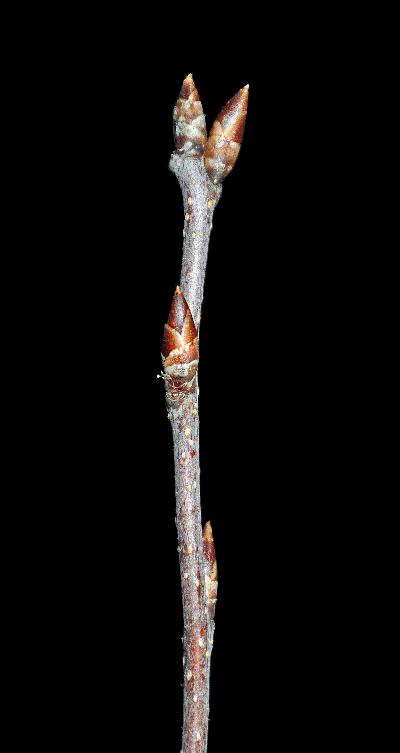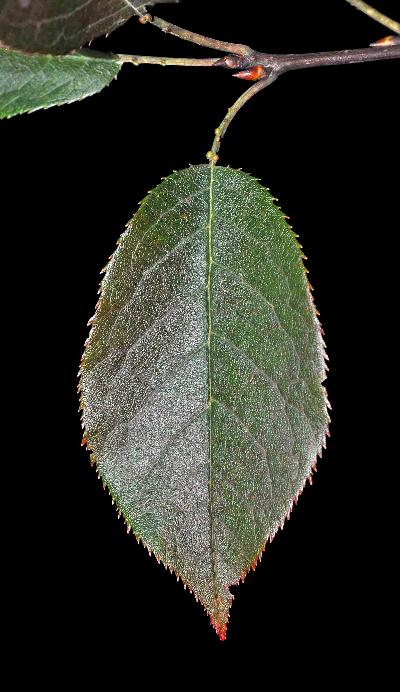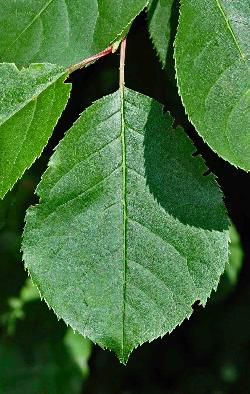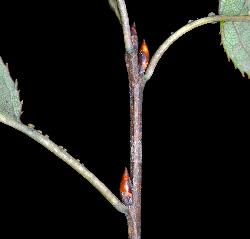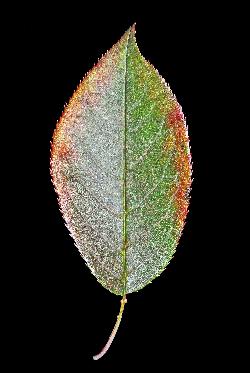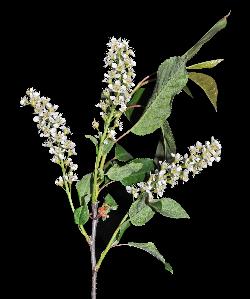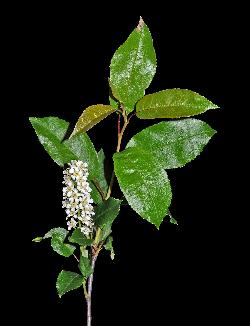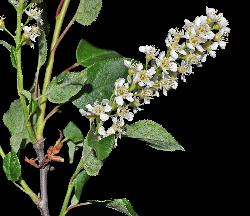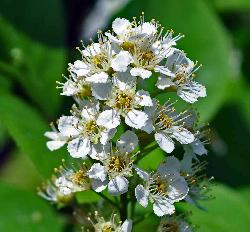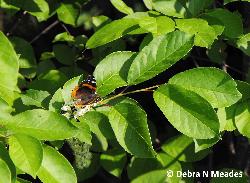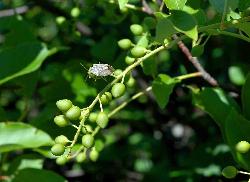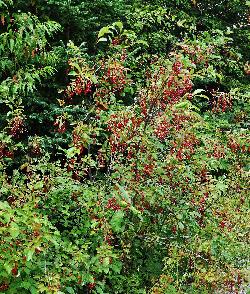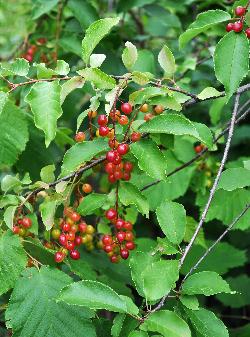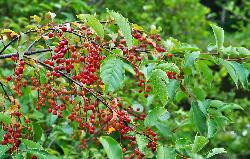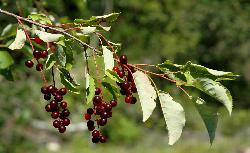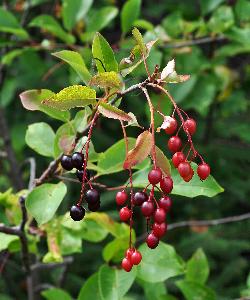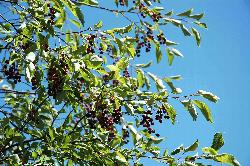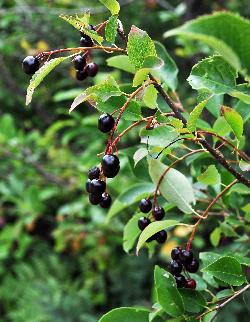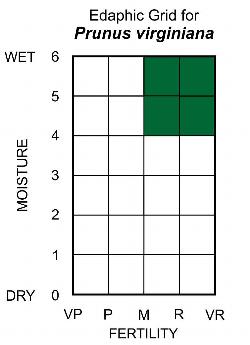Fr: cerisier de Virginie, cerisier à grappes
Rosaceae - Rose Family
Note: Numbers provided in square brackets in the text refer to the image presented above; image numbers are displayed to the lower left of each image.
General: A tall deciduous shrub to short tree, usually 2–6 m tall [1–2]; less frequently, tall trees may be found that can reach 10-15 m in height with a d.b.h. of up to 20 cm (Scoggan 1978, Vilkitis 1974). Chokecherry is an attractive spring-blooming species that produces elongate inflorescences (racemes) of white flowers followed by nodding clusters of red to purplish black fruits [3–4]. Chokecherry is a shade-intolerant species that usually occurs in open forests, clearings, and edges, rather than in dense forest stands; it grows most commonly in disturbed areas, such as riverbanks, roadsides, abandoned fields, rights-of-way, and dune areas. Due to its ability to colonize disturbed areas, chokecherry is useful in erosion control; it prefers rich moist soils with a pH of 6.0–8.0 (Vilkitis 1974). Chokecherry is a shallow-rooted species, but has an extensive lateral root system and can reproduce vegetatively through rhizomes, root sprouts, and suckers, often producing dense thickets that provide cover for small mammals and nesting birds (Mulligan and Munro 1981, Johnson 2000). Chokecherry fruits are eaten by a variety of birds, small mammals, and black bears, and the buds and twigs provide winter browse for snowshoe hare and grouse (Johnson 2000). Like pin cherry, chokecherry plants are susceptible to infection by black knot fungus (Apiosporina morbosa (Schw. ex Fr.) Arx). The typical variety (var. virginiana) of Prunus virginiana is the only variety found in Newfoundland (Brouillet et al. 2010+); traits described here are of var. virginiana.
Warning: Chokecherry seeds and wilted foliage contain significant amounts of cyanogenic glycosides (amygdalin and prunasin), toxic compounds that releases hydrogen cyanide (HCN) when the seeds are crushed or chewed (Munro 2013). Ingestion of large quantities of chokecherry seeds can be fatal, but their bitter taste is usually enough to prevent people from eating quantities large enough to result in poisoning. The presence of cyanogenic glycosides, which are also found in the young leaves and stems, are responsible or the bitter-almond taste of chokecherry and pin cherry twigs. Livestock may also be poisoned by eating chokecherry leaves and seeds (Mulligan and Munro 1981).
Key Features:
1. Leaves simple, alternate, usually elliptic to obovate, with a broad-tapering to rounded base and an acute to abruptly acuminate apex [3]; margins are sharply serrate;
several dome-shaped glands are present along the petiole.
2. Flowers are arranged in elongate racemes [4]; the numerous small flowers have a 5-lobed green calyx, 5 orbiculate white petals, numerous stamens, and a single superior
ovary.
3. Chokecherry fruits are ovoid drupes that occur in pendant clusters [5]; the fruits are green to red when immature, but mature to dark purplish-black.
Stems/twigs: Chokecherry stems have dark grayish-brown glabrous bark [6], older stems have bark marked with irregular vertical striations. Twigs are reddish brown to purplish-gray, dotted by small elliptic pale lenticels, and, like pin cherry, have a disagreeable bitter almond taste and smell when crushed; both lateral buds and true terminals buds are present. Buds are alternate, lanceolate, sharply pointed (acuminate), glabrous, and have several 2-toned overlapping bud scales with pale brown to silvery-gray margins above a darker brown base [7–8]. Leaf scars are hemispherical to elliptic, with 3 bundle trace scars.
Leaves: Alternate, simple, pinnately-veined, and petiolate. Leaves are usually obovate, but may be elliptic, ovate, oblanceolate, or broadly obovate [9–10]; leaf blades are 4–9 cm long by 2–5 cm broad; however, vigorous root shoots often have much larger leaves (to 12 cm long by up to 6.6 cm wide). Leaf blades are widest above the middle, usually less than 2 times longer than wide, and have 6–13 pairs of lateral veins. The upper surface is dark green and glabrous; the lower surface is paler and glabrous to slightly glaucous [11]; some plants may have tufts of fine white hairs in the axils of the midrib and secondary veins. The 0.4–-2.2 cm long petiole is usually glabrous, green to red, and bears several domed or disk-shaped glands towards the blade [12–13]. Leaf bases are broadly tapering (cuneate) to rounded, occasionally slightly cordate; the blade tapers abruptly to an acute to short acuminate apex; and leaf margins are finely serrulate with slender sharp teeth [14]. Leaves turn bronze to yellow, orange, or red in autumn [15–16].
Flowers: Bisexual, with 10–45 fragrant flowers arranged in elongate spreading racemes, 4–7 cm long [17–19]; pedicels are 4-8 mm long and divergent. Individual flowers are about 4–6 mm across and have a cup-shaped hypanthium, 1.5–2 mm long, lined inside with nectar-producing tissue and surrounding a single superior ovary. Attached to the rim of the hypanthium are 5 reflexed calyx lobes, less than 1 mm long, with obtuse apices and glandular serrate margins; 5 white obovate to nearly orbicular petals, 2.5–4 mm long, with ragged (erose) margins; and 20–30 stamens [20]. Flowers bloom shortly after the leaves emerge in spring; pollination is by a variety of insects (entomophily), including bees, flies, flower beetles, and butterflies [21].
Fruit: Arranged in drooping cluster of small ovoid to nearly globose fruit (drupes), each 8–10 mm in diameter. Immature fruit are green to dark red [22–24], but mature to a deep purplish-black [25–29]. The flesh of the fruit is very tart but edible; however, the single seed contained within each stony pit should not be eaten due to its high levels of cyanogenic glycosides, a toxic compound; see warning above. Fruits mature in late summer and are dispersed by frugivorous birds, small mammals, and black bear (endozoochory) (Vilkitis 1974).
Ecology and Habitat: Chokecherry is not common in Newfoundland forests, but appears to prefer more open conditions associated with rich moist soils in alder swamps and shorelines. It is an early successional species that is shade-intolerant, but can spread rapidly in open habitats by root sprouts and suckers (Mulligan and Munro 1981).
Edaphic Grid: See image [30]: the Edaphic Grid for Prunus virginiana.
Forest Types: Chokecherry does not occur in Labrador and is only recorded in the Newfoundland forest classification from the following alder swamps:
Alnetum dryopteretosum (Dryopteris-Alder Swamp Subassociation)
Alnetum solidagietosum (Solidago-Alder Swamp Subassociation)
Succession: Chokecherry is not widespread in Newfoundland and it is not a common component of burns and cutovers, old fields, and roadsides, as is commonly the case where it occurs in mainland Canada. Northland Associates (1990) recorded two sporadic occurrences of chokecherry on moist cutovers in central Newfoundland. Vilkitis (1974) describes its ability to spread as follows: "Chokecherry is a very competitive shrub due to its tolerance for adverse climate and site conditions such as cold temperatures, shade and drought and its ability to sprout prolifically." It grows rapidly once established and forms dense thickets of suckers and sprouts from an extensive lateral root system. Tall chokecherry trees have been observed along the Humber River, near the Humber Gorge [1].
Distribution: Chokecherry is native to north-temperate and southern boreal North America. The typical variety, Prunus virginiana var. virginiana, has a range that extends from Newfoundland west to British Columbia to southern portions of the Northwest Territories, north to about 62° N (Mulligan and Munro 1981, Brouillet et al. 2010+). It is found across insular Newfoundland, but extends north onto the Great Northern Peninsula only as far as Portland Creek (Rouleau and Lamoureux 1992); it is absent from Labrador. In the United States, chokecherry occurs across the northern half of the contiguous States, extending south in the east, along the Appalachians, to Tennessee, North Caroliana, and northern Georgia, extending westward into the Midwest, from North Dakota and Nebraska to Oklahoma (USDA, NRCS 2016). In some Midwest States and western North America, western chokecherry (Prunus virginiana var. demissa (Nutt.) Torr.), replaces or occurs with the typical variety. Western chokecherry has narrower leaves that are pubescent on the lower surface and longer racemes with larger flowers; it occurs from British Columbia east to Manitoba and south through California, east along the Mexican border, to western Texas (Brouillet et al. 2010+, USDA, NRCS 2016).
Similar Species: The only other cherry native to Newfoundland is the pin cherry (Prunus pensylvanica L.f.), which has narrower lanceolate leaves, usually with acuminate apices. Its white flowers are borne in umbel-like clusters; the fruit are bright red drupes with a single stone (endocarp).



